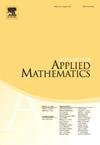Further results on r-Euler-Mahonian statistics
IF 1.3
3区 数学
Q3 MATHEMATICS, APPLIED
引用次数: 0
Abstract
As natural generalizations of the descent number () and the major index (), Rawlings introduced the notions of the r-descent number () and the r-major index () for a given positive integer r. A pair of permutation statistics is said to be r-Euler-Mahonian if and are equidistributed over the set of all permutations of . The main objective of this paper is to confirm a recent conjecture posed by Liu which asserts that is -Euler-Mahonian for all positive integers g and ℓ, where denotes the g-gap ℓ-level excedance number and denotes the g-gap ℓ-level Denert's statistic. This is accomplished via a bijective proof of the equidistribution of and where . Setting , our result recovers the equidistribution of and , which was first conjectured by Denert and proved by Foata and Zeilberger. Our second main result is concerned with the analogous result for which states that is -Euler-Mahonian for all positive integers g and ℓ.
r-Euler-Mahonian统计的进一步结果
作为下降数(des)和主索引(maj)的自然推广,Rawlings引入了给定正整数r的r-下降数(rdes)和r-主索引(rmaj)的概念。如果(st1,st2)和(rdes,rmaj)在{1,2,…,n}的所有排列的集合Sn上是均匀分布的,那么一对(st1,st2)排列统计量就是r- euler - mahonian。本文的主要目的是证实Liu最近提出的一个猜想,即对于所有正整数g和r, (gexc r,gden r)是(g+ r−1)-Euler-Mahonian,其中gexc r表示g-gap r -level的超越数,gden r表示g-gap r -level的Denert's统计量。这是通过客观证明(gexc r,gden r)和(rdes,rmaj)的均匀分布来实现的,其中r=g+ r−1。设g= r =1,我们的结果恢复了(des,maj)和(exc,den)的均匀分布,这是由Denert首先推测并由Foata和Zeilberger证明的。我们的第二个主要结果与(geexc r,gdeng+ r)的类似结果有关,该结果表明(geexc r,gdeng+ r)对于所有正整数g和r都是(g+ r−1)-欧拉-马霍尼量。
本文章由计算机程序翻译,如有差异,请以英文原文为准。
求助全文
约1分钟内获得全文
求助全文
来源期刊

Advances in Applied Mathematics
数学-应用数学
CiteScore
2.00
自引率
9.10%
发文量
88
审稿时长
85 days
期刊介绍:
Interdisciplinary in its coverage, Advances in Applied Mathematics is dedicated to the publication of original and survey articles on rigorous methods and results in applied mathematics. The journal features articles on discrete mathematics, discrete probability theory, theoretical statistics, mathematical biology and bioinformatics, applied commutative algebra and algebraic geometry, convexity theory, experimental mathematics, theoretical computer science, and other areas.
Emphasizing papers that represent a substantial mathematical advance in their field, the journal is an excellent source of current information for mathematicians, computer scientists, applied mathematicians, physicists, statisticians, and biologists. Over the past ten years, Advances in Applied Mathematics has published research papers written by many of the foremost mathematicians of our time.
 求助内容:
求助内容: 应助结果提醒方式:
应助结果提醒方式:


